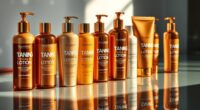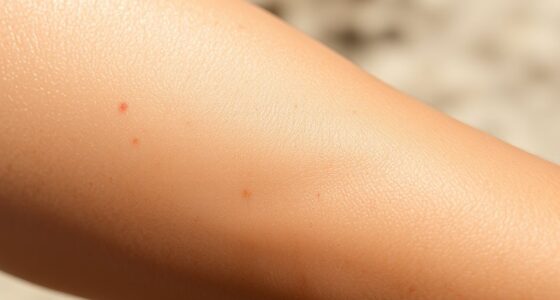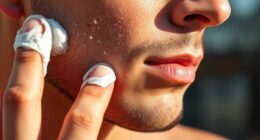To start tanning safely, assess your skin type to determine your UV response and choose appropriate tanning bed levels and durations, beginning with shorter sessions. Prepare your skin by exfoliating and ensuring it’s clean and dry, then wear approved goggles and remove jewelry to protect your eyes and skin. Afterward, hydrate, moisturize, and monitor your skin for any reactions. For tips on extending your tan and avoiding common mistakes, learn more to achieve a healthy, even glow.
Key Takeaways
- Assess your skin type to determine safe tanning levels and protection measures before starting.
- Prepare your skin by exfoliating, cleansing, and avoiding moisturizers or perfumes on the day of tanning.
- Begin with low UV exposure sessions, gradually increasing duration based on your skin’s response and comfort.
- Always wear approved eye protection, remove jewelry, and follow safety guidelines to prevent skin and eye damage.
- Maintain and extend your tan by hydrating, moisturizing regularly, and avoiding overexposure or hot showers.
Assessing Your Skin Type for Safe Tanning
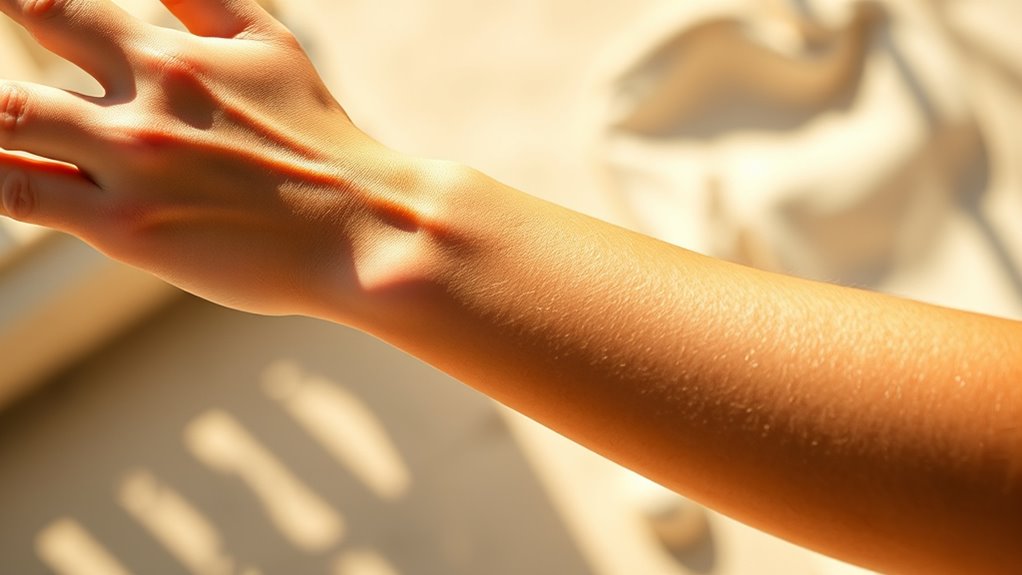
Before you begin tanning, it’s essential to identify your skin type to guarantee safe and effective results. Knowing your Fitzpatrick skin type helps predict how your skin responds to UV exposure and reduces the risk of burns or damage. To determine your type, look at your skin color, hair, and eye color. For example, if you have very fair skin, red or blond hair, and blue or green eyes, you likely belong to Type I — always burns and never tans. If your skin is dark brown or black and rarely burns, you’re probably Type VI, which tans deeply and never burns. You can also use self-assessment questionnaires or consult a dermatologist for an accurate classification. This knowledge guides you in choosing appropriate tanning durations, products, and protection measures. Understanding your optimal tanning angles can also influence the safety and effectiveness of your tanning session. Additionally, being aware of your skin’s UV response allows you to tailor your exposure to minimize damage while achieving your desired tan. Recognizing your personal tanning capacity can help set realistic expectations and prevent overexposure. Moreover, understanding your local environmental conditions, such as UV index and weather, can further optimize your tanning safety and results. Incorporating proper protective measures, like sunscreen or protective clothing, is essential regardless of your skin type to prevent long-term skin damage.
Preparing Your Skin Before the Session

Getting your skin ready for tanning means setting the stage for a smooth, even, and long-lasting glow. Start by showering, shaving, and exfoliating 1 to 2 days before your session, giving your skin time to recover and maximize tan absorption. Use physical exfoliators like scrubs, loofahs, or gloves to buff away dead skin, especially on rough areas like elbows, knees, and ankles. Avoid applying moisturizers or perfumes on the day of tanning; instead, lightly moisturize after exfoliating to keep your skin hydrated, focusing on dry patches a few hours prior. Make sure your skin is clean and free of products like deodorant or makeup to prevent streaks. Proper skin preparation creates a clean, smooth base, ensuring an even, radiant tan. Additionally, understanding industry trends can help you choose the best tanning products and techniques for your skin type. Staying informed about new formulations can also enhance your tanning experience and results. Being aware of sunscreen use can help protect your skin during the process and maintain your tan longer. Incorporating knowledge about technological advancements in skincare can further optimize your tanning session and results.
Selecting the Ideal Tanning Bed Level and Duration

Choosing the right tanning bed level and session duration is essential for safe and effective tanning. If you have fair skin or are a beginner, start with Level 1 or Level 2 beds, which use lower UVB rays and offer gentler exposure. Begin with 5-minute sessions, and if your skin tolerates it, gradually increase by 2-minute increments. For darker skin or more experienced tanners, higher-level beds (Levels 3-6) provide faster, deeper tans but require shorter sessions due to their higher UVA intensity. Always listen to your skin—if you notice redness or discomfort, reduce your time. Remember, building a base tan with lower levels first helps protect your skin and ensures a safer, more even tan as you progress. Incorporating skin protection strategies can further minimize risks associated with tanning.
Following Safety Protocols During Tanning

Following safety protocols during tanning is crucial to protect your skin and maximize your results. Limit your sessions to the recommended time for your skin type to prevent burns and damage. Always wait at least 24 hours between sessions, allowing your skin to recover and reducing UV harm. Start with short exposures and gradually increase to build a safe, even tan. Never fall asleep or doze off during a session, as this can lead to overexposure. Stick strictly to the suggested durations, regardless of how your skin begins to tan. Hydrate well before and after tanning to keep your skin moisturized and healthy. Exfoliate gently beforehand to promote even tanning, and apply moisturizers afterward to extend your tan safely. Monitoring the UV exposure levels during each session helps ensure you stay within safe limits while achieving your desired tan. Additionally, being aware of skin type considerations can help tailor your tanning routine more effectively. Understanding the importance of sunscreen use can further protect your skin from potential damage. Incorporating proper session scheduling can also help you maintain safe tanning practices and avoid overexposure. Practicing these safety measures, along with knowledge of UV effects, can significantly reduce the risk of skin damage and long-term health issues. Following these protocols helps you tan effectively while minimizing risks.
Ensuring Proper Eye and Jewelry Protection

Protecting your eyes and jewelry during tanning is essential to prevent damage, irritation, and uneven results. Always wear UV-blocking goggles that are FDA-approved and fit well, ensuring full coverage of your eyes. Keep your eyes closed under the goggles for extra protection, and remove contact lenses beforehand to avoid UV trapping and irritation. Limit your tanning time and avoid peak sunlight hours to reduce UV exposure. For jewelry, remove all pieces before tanning to prevent skin irritation, discoloration, or burns caused by metal reacting to UV rays. After your session, clean your jewelry to maintain its condition. Additionally, understanding the safety considerations associated with tanning helps minimize risks and promotes a healthier tanning experience. Proper protective equipment is vital to ensure safety while achieving an even tan. Following these steps minimizes risks and helps you enjoy a safe, even tan while safeguarding your eye health and skin integrity.
Techniques for Achieving an Even Tan
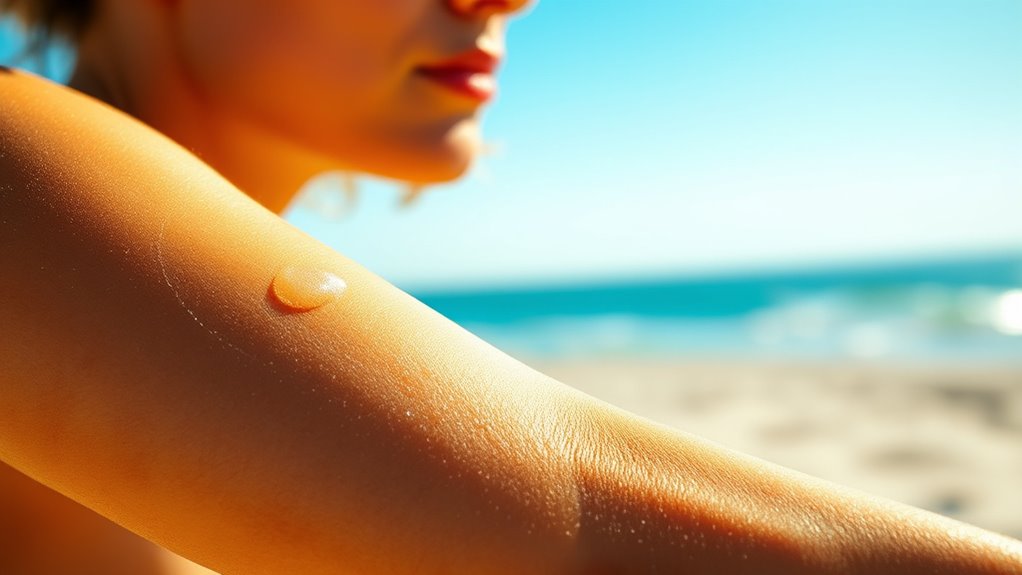
To achieve an even tan, proper preparation is key. Start by exfoliating your skin 24 hours before applying self-tanner to remove dead skin cells and create a smooth surface. Moisturize dry areas like elbows and knees beforehand to prevent uneven color development. Remove unwanted hair a day prior for better absorption. On application day, avoid deodorants and perfumes that can interfere with the tan. Use a mitt to apply the product, working in circular motions on the lower body and long strokes over larger areas. Focus on blending well, especially around tricky spots like knees, elbows, hands, and feet. For a natural look, choose products with guide colors and green pigments to minimize orange tones. Taking these steps helps ensure a flawless, even tan.
Post-Tanning Skin Care and Maintenance
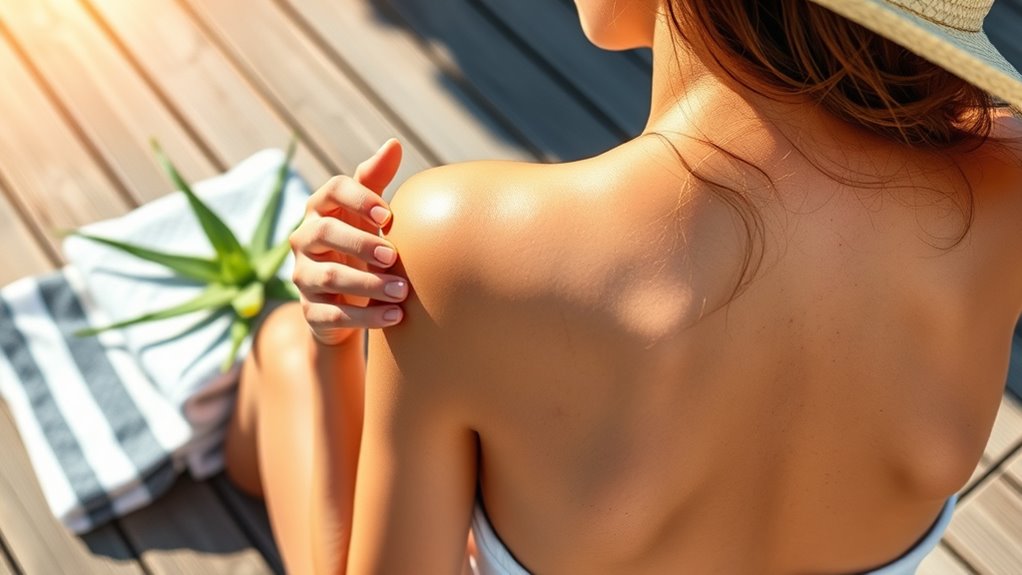
After achieving a beautiful tan, caring for your skin is essential to maintain your glow and prevent irritation. Hydrate your skin regularly with moisturizers containing aloe vera, shea butter, or hyaluronic acid to replenish moisture and prolong your tan. Use fragrance-free, non-greasy products to avoid clogged pores and irritation. Applying aloe vera gel or cool compresses helps soothe redness and heat. Be gentle when cleansing—choose fragrance-free, mild cleansers—and steer clear of alcohol-based products that can dry out your skin. To extend your tan, consider using tan extenders and wear loose, protective clothing to prevent friction. Also, drink plenty of water and avoid harsh soaps. Incorporate nourishing masks and calming formulas to keep your skin healthy, vibrant, and well-maintained. Remember that environmental factors like pollution can negatively affect your skin, so protecting it from air pollution can help preserve your healthy glow. Additionally, paying attention to sun exposure even after tanning can prevent skin damage and maintain your skin’s overall health. Maintaining a proper skincare routine can also enhance your skin’s resilience against skin irritation, especially when exposed to various environmental stressors. Regularly monitoring your skin’s condition and avoiding harsh chemicals will also support your skin health in the long run.
Recognizing and Responding to Skin Reactions

Recognizing skin reactions early can help you prevent more serious issues and guarantee a safe tanning experience. If you notice itching, redness, or bumps during tanning, stop immediately and assess your skin. Warmth, tenderness, or swelling signals a more serious reaction that may require medical attention. Persistent rashes or worsening symptoms after tanning could indicate infection or severe irritation. White spots or scaly patches might mean dehydration or skin damage from UV exposure. Keep an eye out for systemic symptoms like fever, which could point to infection. If any unusual reaction occurs, cease tanning, consult a professional or healthcare provider promptly, and avoid applying sunscreen before tanning beds. Using soothing, moisturizing lotions can help calm irritated skin and prevent further reactions. Incorporating proper workspace organization techniques can also help reduce stress and improve your overall well-being during recovery from skin reactions. Additionally, understanding skin sensitivity can aid in choosing appropriate tanning methods and protective measures. Recognizing how energetic alignment influences your skin health may also contribute to a more positive tanning experience.
Tips for Extending and Preserving Your Tan
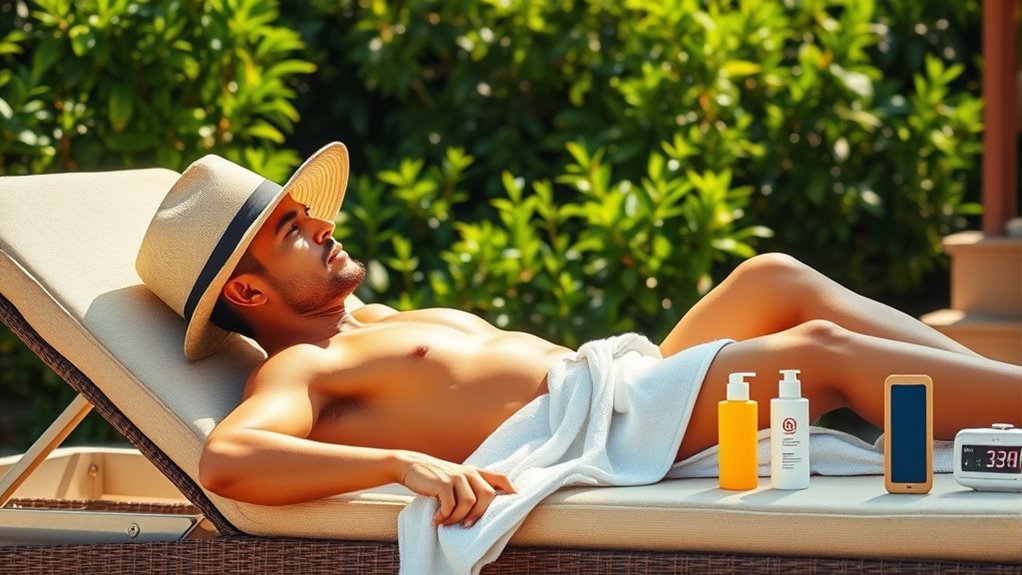
Maintaining healthy, hydrated skin is key to preserving your tan and preventing premature fading. Drink at least 8 glasses of water daily and eat water-rich foods like watermelon, cucumbers, and oranges to keep your skin moisturized from within. Use a moisturizer daily, especially those with aloe vera, hyaluronic acid, or shea butter, to lock in hydration. Taking cool showers instead of hot baths helps prevent dehydration and skin dryness. Apply rich body butters, oils, or tan extender moisturizers every other day to maintain your color. Focus on dry areas like elbows and knees, and moisturize both morning and night. Avoid alcohol-based products, sulfates, and mineral oils, which can dry out your skin. Finally, exfoliate gently once a week to keep your tan even and your skin smooth.
Common Mistakes Beginners Should Avoid
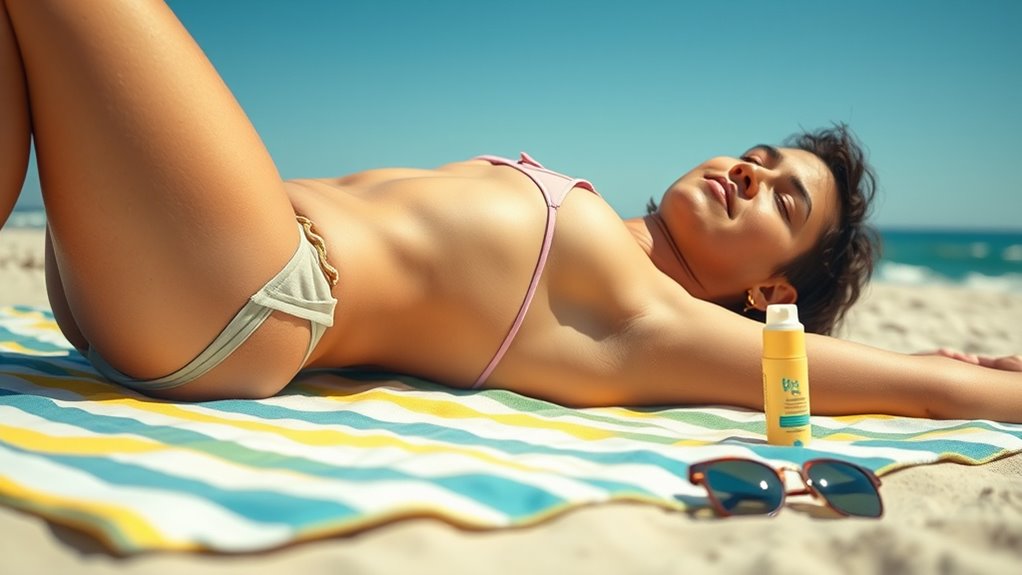
Beginners often make simple mistakes that can ruin their tanning experience or harm their skin. Skipping sunscreen entirely increases your risk of sunburn and long-term damage, so always apply and reapply sunscreen, especially after swimming or sweating. Avoid exposing your skin during peak hours (10 a.m. to 4 p.m.) to minimize UV damage. Prolonged exposure without breaks can cause burns and skin aging. Don’t rely on tanning beds—they dramatically raise your cancer risk. In self-tanning, skipping exfoliation leads to uneven results, and applying on oily or moisturized skin causes streaks. Not blending properly or choosing the wrong shade results in blotchy or unnatural tans. Ultimately, avoid hot showers immediately after tanning, as they can strip your tan and irritate your skin.
Frequently Asked Questions
Can I Tan if I Have Sensitive or Allergy-Prone Skin?
You can tan if you have sensitive or allergy-prone skin, but you should be cautious. UV exposure increases your risk of skin damage and reactions, so limit natural or artificial tanning. Consider safer options like hypoallergenic spray tans or self-tanning lotions with gentle ingredients. Always inform professionals about your skin type, do a patch test first, and moisturize afterward. Prioritize skin health and consult a dermatologist for personalized advice.
How Often Can I Safely Schedule Tanning Sessions?
Imagine you’re in a time before smartphones—now, you ask how often you can tan safely. You should start with 2-3 sessions per week, giving your skin at least 48 hours to recover. Keep sessions short, around 3-10 minutes based on your skin type. As long as there’s no irritation, gradually increase to 3-4 times weekly, then maintain with 1-2 sessions for upkeep.
Is It Safe to Tan With Certain Medications or Skincare Products?
You should be cautious about tanning if you’re on certain medications or using specific skincare products. Photosensitizing drugs like antibiotics, diuretics, or retinoids can increase your skin’s sensitivity to UV rays, raising your risk of burns and damage. Some skincare ingredients, such as retinoids or alpha hydroxy acids, also heighten UV sensitivity. Always consult your healthcare provider before tanning, and choose safer options like FDA-approved sunless tanning lotions.
What Should I Do if I Experience Skin Irritation During Tanning?
When skin irritation strikes during tanning, don’t ignore it. Immediately stop tanning and step into a cool, shaded area. Apply a soothing aloe vera gel or cold compress to reduce inflammation and itchiness. Keep your skin hydrated and avoid scratching. If irritation worsens or persists, see a healthcare professional. Acting swiftly can prevent more serious damage and help your skin recover faster.
How Can I Tell if I’m Overexposing or Burning My Skin?
You can tell you’re overexposing or burning your skin if it turns pink or red quickly, feels hot, tender, or sensitive to touch. Watch for delayed symptoms like pain, swelling, or inflammation that appear hours later. If your skin develops a rash, darkens, or feels leathery, you’re likely overdoing it. To prevent damage, limit sun exposure, wear protective clothing, and apply sunscreen regularly.
Conclusion
Remember, your journey to a golden glow is all about gentle steps and mindful care. By respecting your skin’s whispers and following safe practices, you’ll enjoy a radiant look that feels just right. Patience and protection are your best friends here, turning each session into a comforting ritual. Embrace your natural beauty and let your confidence shine softly—your perfect tan awaits, subtly revealing your glow without rushing the process.

